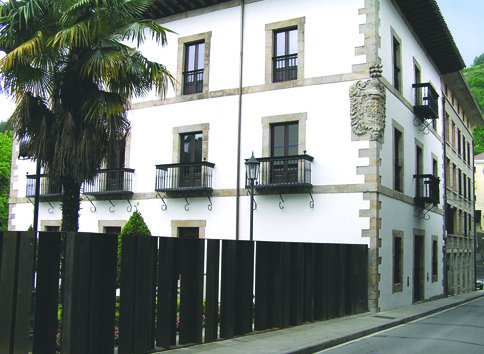“Palacio Urrutia-Espilla” is the original name of this building that was built by the married couple formed by Ignacio Urrutia and Ana Espilla around the middle of the 17th century on the site of an older dwelling. In 1778, the mansion passed into the hands of the Irizar family, which owned it until a few decades ago. This place provided the setting for the signing of the Treaty (Convenio) of Bergara, which put an end to the First Carlist War.
PRESTIGE AND FORTUNE
There is documentary evidence to show that the large house that stood on this site belonged to the Espilla family at the beginning of the 17th century In 1659, Ana de Espilla married Captain Ignacio de Urrutia; this brought together, as was the case on more than one occasion during the Ancien Regime, the prestige afforded by an old and respectable family and the material power provided by huge wealth. Indeed, Captain Urrutia –who had pursued a career in the navy with profitable businesses in Seville and the Americas– brought a vast sum of money to the marriage; Ana de Espilla, for her part, contributed the house and her lands, symbols of an undeniable and prestigious attachment to the town. The couple soon undertook the work to completely refurbish the house and turn it into a veritable palace. The Irizar Palace looks more or less the same today as it did in those days.
JAUREGIA ETA LORATEGIA: ALDERDI ARTISTIKOAK
Irizar jauregia eraikin dotorea da, bolumetria irmokoa eta soiltasun-itxurakoa. Dekorazioa honako elementu hauetan biltzen da batez ere: balkoietako balaustreak —burdina forjatuzko lan bikaina—, ertzeko armarria —Barrenkale eta lorategi aldeetarako fatxadetako ertzean—, eta aberastasun handiz tailatutako egurrezko hegala. Barrualdean, berriz, gu gauden atari handi honetan bertan, azpimarratzekoa da eskailera aldera sarbidea ematen duen arku karpanel handia.
Etxeak, fatxada bati lotuta, antzinako lorategi eder bat du. XVII. mendearen bigarren erdian, Urrutia kapitainak eta Ana Espillak jauregiari dotoretasun berezia eman nahi izan ziotela-eta, antzinako etxeak zituen baratzetatik zati bat kendu eta lorategi bihurtu zuten. Lorategiaren traza diseinatzerakoan, oso kontuan hartu ziren garai hartako Europako kultur guneetan erabiltzen ziren dekorazio geometrikoaren errepertorio ospetsuenak.
Bai jauregiak, bai lorategiak, monumentu-izendapena dute. Jauregiak 1964. urtean lortu zuen; lorategiak, berriz, 2009. urtean.
PALACE AND GARDEN: ARTISTIC ASPECTS
The Irizar Palace is an elegant, round building with an austere aspect, which focuses its main decorative features on the balustrades on the balconies –magnificent wrought ironwork–, on the corner coat of arms –located at the confluence of the facades that look out onto Barrenkalea and the garden– and on the ornately carved timber eave. A highlight inside is the great basket-handle arch leading to the staircase that occupies this ample hallway we are now in.
There is a beautiful old garden running up to one side of the house.
Both the palace and its garden have been listed. The palace was granted that category in 1964, with the garden following it in 2009.
THE TREATY AND EMBRACE OF VERGARA
On 31 August 1839, a meeting was held at this palace between Rafael Maroto –supreme military commander of the Carlist troops– and Baldomero Espartero – commander-in-chief of the liberal army of the North– for the purpose of signing the Treaty of Vergara, which would put an end to the First Carlist War (1833-1839). Besides signing the document, the two soldiers staged the agreement by embracing before the different battalions that had been summoned to our town and were filling the surrounding area.
Espartero promised to do everything in his power to convince the Government not to make the decision to abolish or revoke the Fueros, the specific rights that had been granted to the Basque territories. Article 1 of the Treaty of Vergara reads as follows:
"Captain General Don Baldomero Espartero, shall firmly petition the Government to comply with its offer of formally agreeing to request the Cortes (Parliament) to grant or amend the fueros."
A few months later, however, Espartero –supported by progressive liberals– seized the reins of power in the kingdom: Over these years, he introduced a series of measures that were considered detrimental to the political and administrative organisation of the Basque provinces. He thus ordered chief magistrates to be replaced by senior political chiefs; the implementation of municipal organisation pursuant to the general laws and rules in place in the kingdom; the introduction of provincial councils to replace the former foral ones; the implementation of the general legal system to replace the current system according to the Fueros; approval of the suppression of the Pase Foral [the right to refuse to obey an order from the central government if it contradicted the Fueros], and the customs posts inland between the Basque Country and the rest of Spain were moved to the ports on the coast.
A series of events that occurred between July and December 1843 forced Espartero into exile, and the moderate liberals returned to power. It was at this time (1844) when the Provincial Councils of Gipuzkoa, Bizkaia and Araba managed to reinstate certain parts of the arrangement of Basque rights.
The Second Carlist War was fought in the Basque Country between 1872 and 1876. The conflict ended with the military defeat of the Carlists in the winter of 1876, With Antonio Cánovas del Castillo as prime minister, a Law was enacted on 21 July 1876 which is considered to be the legislation that finally abolished the Fueros. As from that date –1878–, the Basque territories were governed, insofar as economic-administrative matters were concerned, by an economic agreement referred to as the Conciertos Económicos.


